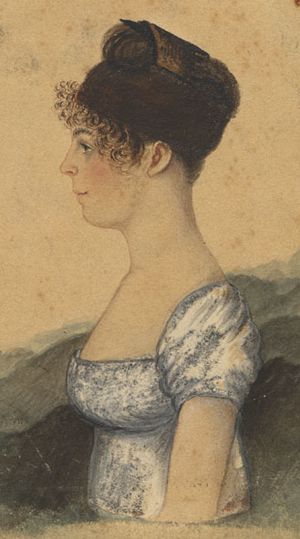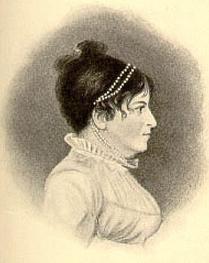Susanna Rowson facts for kids
Quick facts for kids
Susanna Haswell Rowson
|
|
|---|---|
 |
|
| Born | Susanna Haswell 1762 Portsmouth, England |
| Died | 2 March 1824 (aged 61–62) Boston, Massachusetts, United States |
| Resting place | Graupner Family Vault, St. Matthew's Church, South Boston, Massachusetts, United States Moved in 1866 to Mount Hope Cemetery, Boston |
| Pen name | Susanna Rowson |
| Occupation |
|
| Notable works | Charlotte Temple |
| Spouse | William Rowson |
| Relatives | Robert Haswell (brother) James Gabriel Montresor (uncle) John Montresor (cousin) Anthony Haswell (cousin) |
Susanna Rowson (born Haswell, 1762 – 1824) was an amazing American writer, poet, actress, and teacher. Many people see her as the first woman geographer and a strong supporter of education for girls. She also spoke out against slavery.
She wrote a very famous book called Charlotte Temple in 1791. It was the best-selling book in America for a long time, until Uncle Tom's Cabin came out. Susanna Rowson also wrote the first geography textbook in America in America in 1805, which focused on people and cultures.
Contents
Susanna Rowson's Life
Early Life and Moving to America
Susanna Haswell was born in 1762 in Portsmouth, England. Her father, William Haswell, was a Royal Navy officer. Her mother, Susanna Musgrave, died soon after she was born.
When her father was working in Boston, he married Rachel Woodward. In 1767, he brought Susanna and a servant to Massachusetts. Their ship got stuck near Lovells Island in Boston Harbor. Luckily, everyone was rescued a few days later.
They lived in Nantasket (now Hull). A family friend, James Otis, helped Susanna with her education. When the American Revolution began, her father was put under house arrest. The family then moved to Hingham and Abington, Massachusetts.
In 1778, her father's health was poor. The family was sent to England through Halifax. They settled near Kingston upon Hull. Their property in America was taken away. They had to sell Susanna's family property to support themselves.
Becoming a Writer and Actress
Susanna worked as a governess in Westminster. There, she wrote her first book, Victoria, which was published in 1786. On October 17, 1786, she married William Rowson. He was a merchant and also a trumpeter for the Royal Horse Guards.
In 1791, she published her most famous novel in London. It was called Charlotte: A Tale of Truth. Later, it was reissued in America as Charlotte Temple. This book became the first best-selling novel in the new United States. Over 200 different versions of the story have been printed.
After her husband's business failed, Susanna and William became actors. They also took in William's orphaned sister, Charlotte. William acted with the Theatre Royal, Covent Garden. Susanna joined the Theatre Royal, Edinburgh.
In 1793, the three Rowsons moved to America. They joined a theater company in Philadelphia and also performed in Baltimore.
Life in America and Education
Over the next three years in Philadelphia, Susanna was very busy. She wrote a novel, an opera, and a musical play. She also wrote poems and songs for the theater company. She performed in many different plays. Her work helped performing arts grow in the United States.
Susanna's play, Slaves in Algiers, talked about new ideas of freedom and women's roles. Some people, like William Cobbett, criticized her for these ideas. But Susanna was not afraid to speak her mind.
In 1796, Susanna and William moved to Boston. This was closer to where she had lived as a child. In 1797, Susanna stopped acting. She opened the first "female academy" in Boston. It was called "Mrs. Rowson's Academy for Young Ladies." Students from her school created some of the earliest American map samplers. These showed detailed maps of Boston Harbor.
Susanna moved her school to Medford, then to Newton, Massachusetts. In 1809, she brought it back to Boston. She was a leader in education for girls. She was also the first woman geographer. In 1805, she published Rowson's Abridgement of Universal Geography. This textbook focused on human geography, not just maps. It included information on women's roles, cultures, and religions. It also strongly spoke out against the "barbarous, degrading traffic" of slavery. She also published Youth's First Steps in Geography in 1811. She ran her school until 1822, teaching hundreds of girls.
Later Years and Legacy
Susanna continued to write while running her school. She wrote more novels, another play, and a dictionary. She also contributed to the Boston Weekly Magazine. Her writing and teaching helped support her growing household.
Susanna and William did not have their own children. But they raised many others. They took in William's son, two adopted daughters, and her niece. She also hosted her half-brother's widow and daughters. One of her nieces, Rebecca Haswell, became the great-grandmother of the famous poet E. E. Cummings. Susanna also led a charity that helped widows and children without fathers.
She retired from her school in 1822. Her adopted daughters took over running it. Susanna Rowson died in Boston two years later, on March 2, 1824. She was buried in a family vault in South Boston. Later, her remains were moved to the Mount Hope Cemetery. A special memorial was built for her and her brothers at Forest Hills Cemetery in Boston. It remembers her as the author of Charlotte Temple.
Works
Fiction
- Victoria (1786)
- The Inquisitor (1788)
- Mary, or, The Test of Honour (1789)
- Charlotte: a Tale of Truth (1791; later called Charlotte Temple)
- Mentoria; or, the Young Lady's Friend (1791)
- Rebecca, or, The Fille de Chambre (1792)
- Trials of the Human Heart (1795)
- Reuben and Rachel; or, Tales of Old Times (1799)
- Sarah (1813)
- Charlotte's Daughter, or, The Three Orphans (1828, a sequel to Charlotte Temple)
Plays
- Slaves in Algiers; or, A Struggle for Freedom (1794)
- The Female Patriot (1795)
- The Volunteers (1795)
- Americans in England (1796)
- The American Tar (1796)
- Hearts of Oak (1811)
Verse
- Poems on Various Subjects (1788)
- A Trip to Parnassus (1788)
- The Standard of Liberty (1795)
- Miscellaneous Poems (1811)
Other Writings
- An Abridgement of Universal Geography (1805)
- A Spelling Dictionary (1807)
- A Present for Young Ladies (1811)
- Youth's first Step in Geography (1811)
- Biblical Dialogues Between a Father and His Family (1822)
- Exercises in History, Chronology, and Biography, in Question and Answer (1822)
Images for kids




